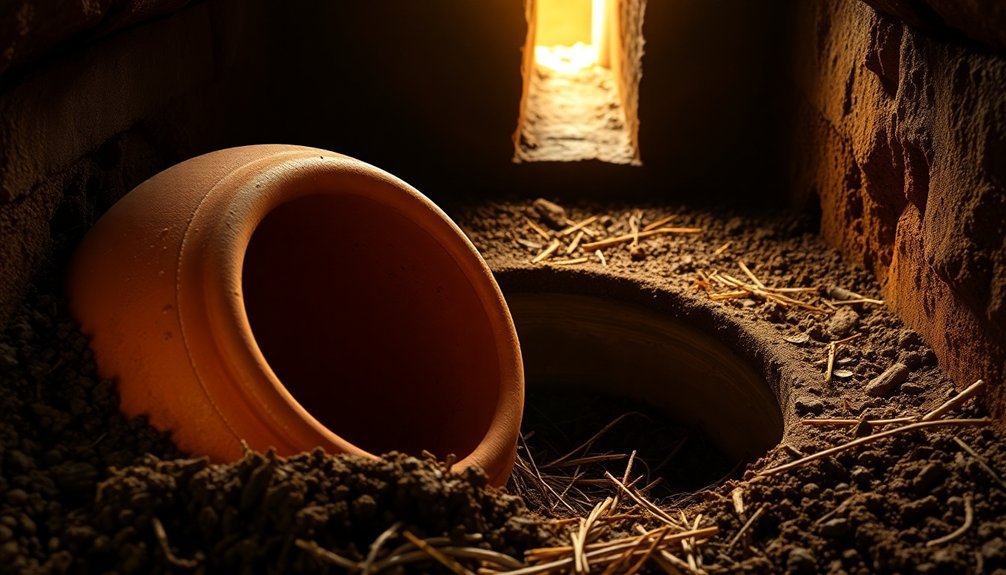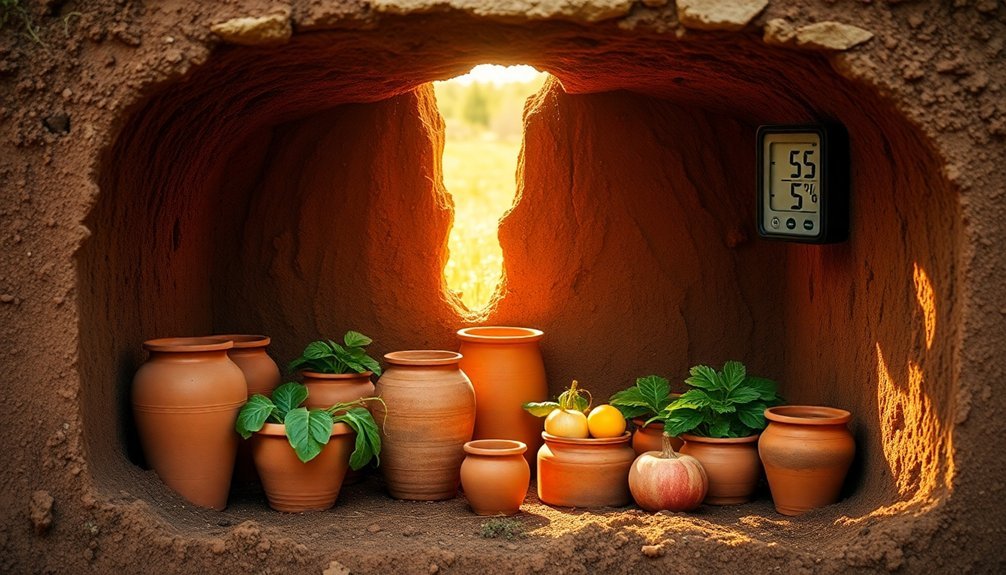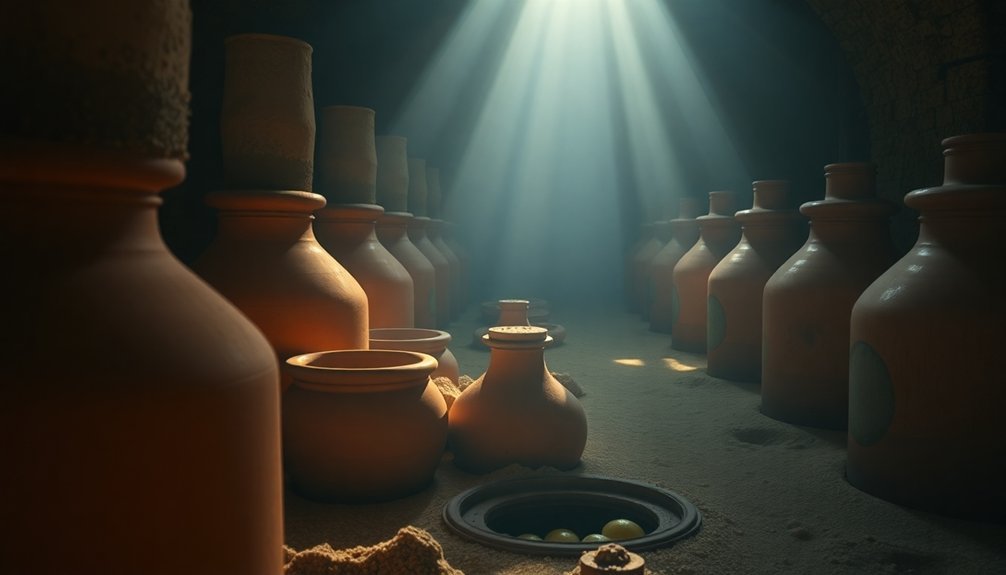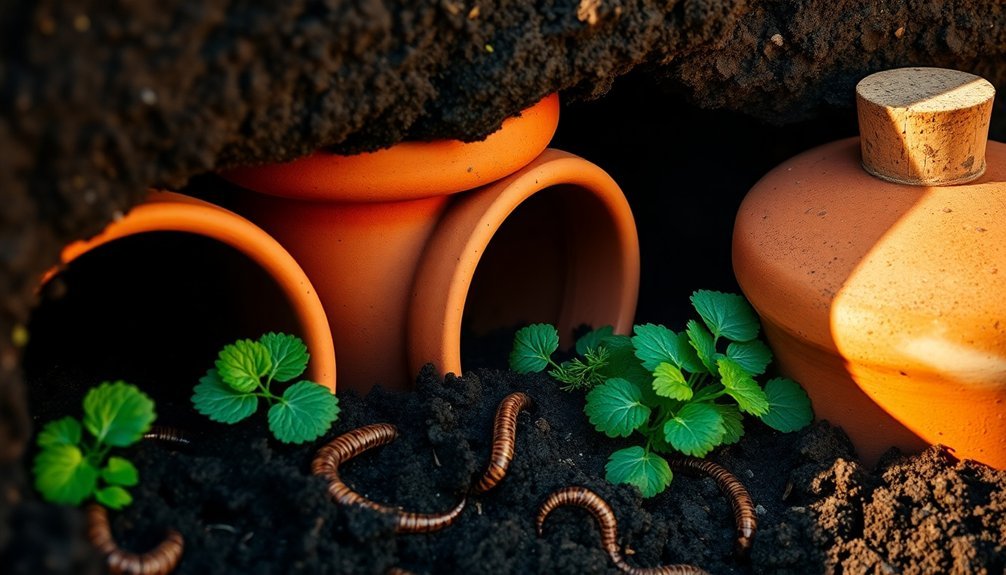French clay pots keep your food fresh underground by tapping into nature's own cooling system. You'll find these pots work through a combination of specialized clay construction and the earth's consistent underground temperatures (50-59°F at 30 feet depth). The iron-rich clay pots, crafted with traditional techniques, create an ideal environment that maintains steady temperatures year-round. When placed underground, they use 25-50% less energy than modern storage methods, while the earth's natural insulation keeps food cooler in summer and warmer in winter. This ancient French innovation holds more secrets than meets the eye.
Ancient French Storage Methods

While modern refrigeration has made food storage easier, the French pioneered sophisticated underground storage methods that shaped colonial preservation techniques in the 17th and 18th centuries.
When French colonists arrived in North America, they adapted these preservation methods to their new environments, drawing inspiration from indigenous storage practices.
You'll find that these early storage systems were remarkably effective, predating modern preservation techniques like canning and freezing. Poor families often relied on shared stew pots for their meals.
The French developed various underground structures, from simple trenches to elaborate multi-chambered cellars built into hillsides.
You'd typically see these storage spaces lined with brick, stone, or logs, with separate areas designated for different types of food.
What made these storage methods particularly effective was their careful construction using materials like clay, masonry, and straw.
Clay proved essential as it created an impermeable barrier against insects and rodents, while masonry and stone provided significant thermal insulation.
If you'd stored food in these underground chambers, you could expect root vegetables to last 5-8 months, cheese up to six months, and dairy products for several weeks, thanks to the consistently cool, humid, and dark conditions.
Clay Pot Construction Features
To craft traditional French clay pots, artisans must master a complex process that begins with selecting coarse, iron-rich clay and removing impurities through levigation. You'll find that the clay's texture becomes smooth after sieving, and when mixed with water, it reaches the perfect consistency for shaping.
| Construction Step | Key Features |
|---|---|
| Initial Forming | Wood ribs and rope template create basic shape |
| Building Method | Hand-building or wheel-throwing techniques |
| Support System | Rope-covered forms prevent collapse during shaping |
| Drying Process | Controlled environment with proper supports |
The construction process requires multiple passes and resting periods, especially for larger pots. You'll see artisans pressing wet clay against rope-covered forms, using various tools to smooth and shape the surface. The historical rope pattern remains visible on the interior after firing. They'll add handles and lids only after the main structure is complete.
During the drying phase, you'll notice the pots are placed in controlled environments, often attics, where they won't dry too quickly and crack. Once the clay reaches a leather-hard state, artisans remove excess clay and add final details. Before firing, they'll remove all wood forms and rope supports, allowing the pot to complete its transformation in the kiln.
Underground Temperature Control System

Traditional French clay pots benefit from three natural temperature control methods when stored underground.
First, you'll find that the earth maintains a consistent temperature between 50°F and 59°F at about 30 feet below the surface, creating an ideal environment for food preservation.
Second, you're taking advantage of the ground's natural heat exchange properties, where the soil stays warmer than air in winter and cooler in summer.
When you store clay pots underground, they work similarly to a geothermal heat exchange system.
The surrounding soil acts as a thermal energy storage medium, helping maintain steady temperatures inside the pots regardless of seasonal changes above ground.
Your food stays fresh because the clay pots interact with the earth's consistent temperature, much like how modern geothermal systems use underground loops to regulate building temperatures.
This method is remarkably efficient, as it uses 25-50% less energy compared to conventional storage methods.
You'll notice this natural temperature control system is particularly effective because it doesn't require any mechanical components or energy input.
The clay pots simply work with the earth's inherent thermal properties, creating a sustainable and efficient food storage solution that's been proven effective for generations.
Seasonal Food Storage Benefits
Storing food in French clay pots throughout the seasons delivers multiple benefits for both quality and cost-effectiveness. You'll find that you can take advantage of peak harvest times when produce is at its most nutritious and affordable. By buying fruits and vegetables when they're naturally abundant and storing them properly in clay pots, you're preserving their rich flavors and high vitamin content without relying on chemical preservation methods.
When you store seasonal produce underground in clay pots, you're not only saving money by purchasing at lower peak-season prices but also supporting local farmers and reducing your carbon footprint. The natural storage method helps maintain the nutritional benefits that align with your body's seasonal needs, like preserving vitamin C-rich citrus for winter consumption or keeping summer's beta-carotene-packed stone fruits.
You're also contributing to environmental sustainability by reducing the need for energy-intensive transportation and storage methods. Clay pot storage allows you to maintain a connection to natural growing cycles while ensuring you have access to high-quality produce beyond its immediate harvest season, all while keeping your food costs down.
Regional Clay Storage Variations

Across the world's arid regions, clay storage systems have evolved to match local conditions and available materials.
You'll find three main variations that have proven effective: clay pot-in-clay pot, clay pot-in-plastic-dish, and clay pot-in-clay dish. Each design uses sand between vessels and damp cloth covers to create an evaporative cooling effect.
Your choice of design often depends on what's readily available in your area. If you're working with local artisans, you'll likely use the clay pot-in-pot system, as pot makers can easily create matching sizes.
However, if you're in an area where plastic containers are common, you might opt for the clay pot-in-plastic-dish variation. These systems are remarkably affordable, costing between $3 and $15 to construct.
You'll see impressive results regardless of which variation you choose. The cooling effect can lower temperatures by up to 10°C below ambient conditions, while increasing humidity preserves your food longer.
For instance, your leafy greens can last over four days instead of just one. These adaptations have shown high adoption rates, with 73% of trained users continuing to use the technology.
Frequently Asked Questions
How Long Does the Clay Need to Dry Before First Underground Use?
You'll need to completely sun dry your clay pot for 2-3 days after the initial preparation and seasoning process. Make sure it's thoroughly dried before using it, as moisture can compromise its effectiveness.
Can Multiple Food Types Be Stored Together in the Same Pot?
You'll need to store compatible foods separately. Don't mix ethylene-producing fruits with sensitive vegetables. Keep strong-smelling items isolated. Group similar moisture-needs together, and always guarantee everything's clean and dry before storing.
What Happens if Groundwater Seeps Into the Storage Area?
If groundwater seeps into your storage area, you'll face serious problems: increased moisture will cause food spoilage, mold growth, and rotting. It'll also weaken your storage structure and reduce preservation methods' effectiveness.
How Do You Protect the Pots From Burrowing Animals?
You'll need to line storage areas with metal mesh, build brick barriers, and cover pots with heavy lids. Keep the area ventilated and clean, and place storage away from animal burrows to prevent intrusion.
What's the Maximum Depth for Optimal Preservation of Different Foods?
You'll find ideal food preservation at 2-3 meters underground, where temperatures remain stable. Don't go deeper, as it won't improve storage conditions and may create access difficulties for your preserved foods.
In Summary
You'll find that French clay pot storage remains surprisingly relevant today for keeping produce fresh without electricity. By adopting these time-tested methods, you're tapping into centuries of food preservation wisdom. Whether you're storing root vegetables or preserving seasonal harvests, you can rely on the natural insulation and humidity control of underground clay storage, just as French farmers have done for generations.





Leave a Reply